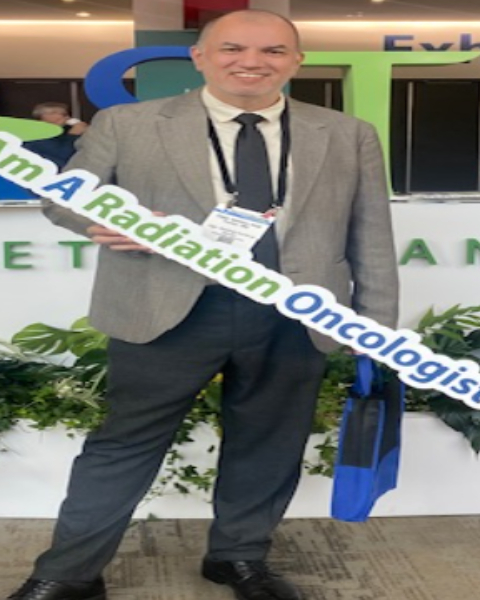PQA 10 - PQA 10 Head & Neck Cancer and Health Services Research/Global Oncology Poster Q&A
3721 - Lessons Learned from an Epic Transformation of a Radiation Oncology Department in Guatemala: Keys to Success
Wednesday, October 2, 2024
10:30 AM - 11:45 AM ET
Location: Hall C
Screen: 32

Edgar Aparicio Ruiz Furlan, MD
Liga Nacional Contra el Cancer
Guatemala, Guatemala
Presenter(s)
E. A. Ruiz Furlan1, H. A. Gay2, M. Ixquiac1, A. Velarde1, B. Sun3, J. L. Garcia-Ramirez4, E. Laugeman5, B. Li6, C. Cardenas7, L. E. Court8, J. Maas9, J. M. Michalski2, V. De Falla1, G. D. Hugo10, and J. van Rheenen11; 1Liga Nacional Contra el Cáncer e Instituto de Cancerología LIGA-INCAN, Guatemala City, Guatemala, 2Department of Radiation Oncology, Washington University School of Medicine, St. Louis, MO, 3Department of Radiation Oncology, Dan L. Duncan Comprehensive Cancer Center, Baylor College of Medicine, Houston, TX, 4Washington University School of Medicine, Department of Radiation Oncology, St. Louis, MO, 5Department of Radiation Oncology, Washington University School of Medicine in St. Louis, St. Louis, MO, 6Department of Radiation Oncology, University of Washington/ Fred Hutchinson Cancer Center, Seattle, WA, 7Department of Radiation Oncology, University of Alabama at Birmingham, Birmingham, AL, 8The University of Texas MD Anderson Cancer Center UTHealth Houston Graduate School of Biomedical Sciences, Houston, TX, 9Orden de Malta, Mixco, Guatemala, 10Washington University School of Medicine in St. Louis, Department of Radiation Oncology, St. Louis, MO, 11Global Health Center, Institute for Public Health, Washington University in St. Louis, St. Louis, MO
Purpose/Objective(s): We describe the radical modernization of a radiation oncology department in a developing country, Guatemala, from 2015 to the beginning of 2024. The "Instituto de Cancerología y Hospital Dr. Bernardo del Valle S" (INCAN) is the only public radiotherapy clinic serving patient referrals from the Ministry of Public Health and Social Assistance program. Materials/
Methods: We describe the state of the radiation oncology department in 2015 versus 2024 while chronicling its gradual transformation. This multifaceted collaboration involved academic centers, government agencies, IAEA, industry, and non-profits and continues to this day. We analyze the infrastructure, radiotherapy equipment, physics department, patient care, finances, Co-60 decommissioning, donation imports, educational initiatives, and fundraising.
Results: Eleven graphs illustrate the impact of these changes in treatment delivery time, consults, follow-up visits, CT simulations, new patients treated in each linear accelerator, new patients treated with 2D, 3D, IMRT/VMAT, and superficial techniques, new patients treated with 2D LDR, 2D HDR, or 3D techniques, causes of linear accelerator downtime, and weekly patients on treatment. We provide a figure of the various sequential and parallel steps to modernize a radiation oncology department. We describe the complexities of radioisotope repatriation and safe disposal. We provide a comprehensive table of wisdom pearls regarding project governance, team, education, finances, culture, and language. We also discuss the impact of artificial intelligence in contouring.
Conclusion: The transformation of the INCAN radiation oncology department in Guatemala is a testimony to manys hard work, vision, and perseverance for the betterment of Guatemalan patients while facing incredible financial hardship. We hope that what we have learned in the past nine years will help others achieve even greater success in a shorter time. Finally, Dr. Edgar Ruiz, chair of the department, gives us his perspective: "The most difficult thing has been working with people who resist change. Staff is used to doing things one way, but little by little, they realize that changes are necessary, and in the end, they get on board, and everything flows better. "
Purpose/Objective(s): We describe the radical modernization of a radiation oncology department in a developing country, Guatemala, from 2015 to the beginning of 2024. The "Instituto de Cancerología y Hospital Dr. Bernardo del Valle S" (INCAN) is the only public radiotherapy clinic serving patient referrals from the Ministry of Public Health and Social Assistance program. Materials/
Methods: We describe the state of the radiation oncology department in 2015 versus 2024 while chronicling its gradual transformation. This multifaceted collaboration involved academic centers, government agencies, IAEA, industry, and non-profits and continues to this day. We analyze the infrastructure, radiotherapy equipment, physics department, patient care, finances, Co-60 decommissioning, donation imports, educational initiatives, and fundraising.
Results: Eleven graphs illustrate the impact of these changes in treatment delivery time, consults, follow-up visits, CT simulations, new patients treated in each linear accelerator, new patients treated with 2D, 3D, IMRT/VMAT, and superficial techniques, new patients treated with 2D LDR, 2D HDR, or 3D techniques, causes of linear accelerator downtime, and weekly patients on treatment. We provide a figure of the various sequential and parallel steps to modernize a radiation oncology department. We describe the complexities of radioisotope repatriation and safe disposal. We provide a comprehensive table of wisdom pearls regarding project governance, team, education, finances, culture, and language. We also discuss the impact of artificial intelligence in contouring.
Conclusion: The transformation of the INCAN radiation oncology department in Guatemala is a testimony to manys hard work, vision, and perseverance for the betterment of Guatemalan patients while facing incredible financial hardship. We hope that what we have learned in the past nine years will help others achieve even greater success in a shorter time. Finally, Dr. Edgar Ruiz, chair of the department, gives us his perspective: "The most difficult thing has been working with people who resist change. Staff is used to doing things one way, but little by little, they realize that changes are necessary, and in the end, they get on board, and everything flows better. "
